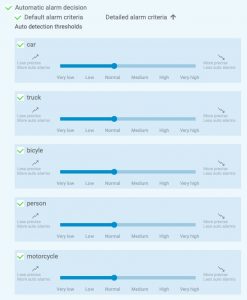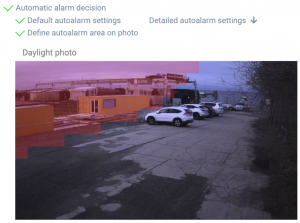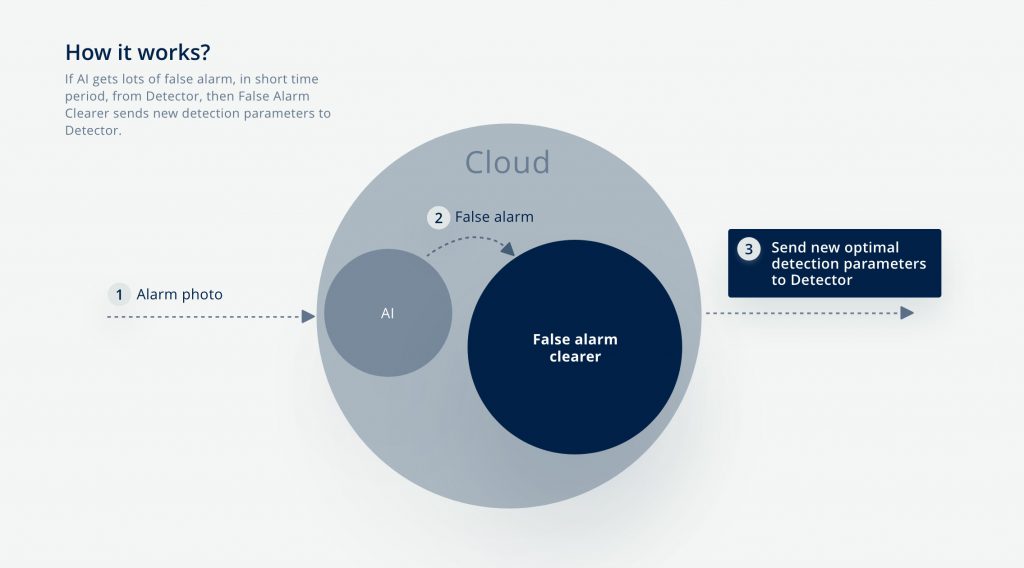False security alarms waste valuable resources and increase response times for real alarms. Even when a team is not dispatched, monitoring centres often charge a fee for any false alarms they need to verify. This is why optimal false alarm filtering has become crucial for successful security companies.
Our video alarm verification system reduces false alarms on average by 95%. Keep reading to find out how we promise our clients almost zero false alarms.
AI false alarm filtering
We use a cloud-based AI model that analyses all images received from the detectors.
Reconeyez system uses object detection technology to detect the presence of persons and vehicles on alarm photos and to filter out false alarms. Reconeyez deep learning algorithms filter out 95% of false alarms in urban environments on average.
By supporting additional features such as ‘Define alarm area on photo’ and ‘arming schedules for devices’, Reconeyez provides monitoring stations with the tools to improve alarm monitoring efficiency and performance.
AI object detection
The main goal of object detection is to identify and visually mark the objects on alarm photos (Auto alarms and Auto dismissed). In the security industry, object detection helps detect unwanted human intruders or cars, monitor environmental changes, and track fly-tipping.
There are 4 possible results for the object detection:
- True Auto alarm or True Positives are the cases where an object (e.g. person) has been predicted as positive, and it indeed is a person on the alarm photo.
- False Auto alarm or False Positives are the cases that have been predicted as positive but they do not have persons on the alarm photo.
- True Auto dismissed or True Negatives are the cases that have been predicted as negative, and they indeed do not have a person on the alarm photo.
- False Auto dismissed or False Negatives are the cases that have been predicted as negative, but they have persons in the alarm photo.
All of the 4 outcomes listed above have different business values. Let’s continue with the analogy of the algorithm that is trying to identify persons in the alarm photo. Under ideal circumstances, the object detection algorithm will detect all alarms with persons on the photos as ‘Auto alarms’ and all alarms with no persons on the photos as Auto dismissed.
Configurations for accurate false alarm filtering

Configurable Auto alarm threshold
Object detection probability threshold allows users to manage the number of Auto alarms. As no Object Detection algorithm is 100% accurate, the user needs to configure an Auto alarm threshold for each object that would suit their needs.
A lower Auto alarm threshold would result in more Auto alarms with potentially more false positive alarms. A higher Auto alarm threshold would result in fewer Auto alarms, but it can also result in some alarms with a lowered probability of object detection (eg. “person” 45%) being discarded as Auto dismissed. It is generally advised not to lower the Auto alarm threshold for any object lower than medium.
Reconeyez also offers a configurable option to ignore some of the detected objects completely by disabling appropriate objects (e.g. “bicycle”) from being detected by an object detection algorithm and consequently from being classified as an Auto alarm.
Define alarm area on photo

We use a ‘define alarm area on photo’ feature, that allows you to determine an area of interest on the given detector’s alarm photo. This defined area will cause the AI to only detect objects from inside this area and ignore all objects from outside of this area.
This handy tool will allow you to ignore parts of the alarm photo, where there is constant movement, e.g. a busy street or a parking lot in the background.
When your auto alarm thresholds and alarm areas are configured to suit the peculiarities of your situation and environment, false alarms are reduced by 95%.
Automated false alarm filtering
Reconeyez also uses a Patent Pending machine learning algorithm to automatically adjust the sensor’s settings.
In the case of multiple false alarms with similar parameters, artificial intelligence automatically adjusts the Detector’s settings to compensate for the false readings.
For example, on a particularly windy day, after filtering out multiple false positive alarms, the AI will increase the auto alarm threshold and update any other relevant detection parameters. After not encountering any more of the same type of alarms for a while, the AI automatically decreases the threshold, returning the detector’s configuration to the normal level when the wind has subsided.
Other tips on how to avoid false alarms
There are several other ways to avoid false alarms from detectors and bridges by correct installation and troubleshooting.
Installation
During installation, it is advised to observe the immediate area in front of the detector for potentially moving objects that can trigger the motion (PIR) sensor. Most such objects, e.g. plants, trash, and plastic covers will not cause false alarms unless there is wind. Removing objects potentially moving in the wind from detector trigger areas is a priceless investment in reducing the number of false alarms.
The same applies to false tamper alarms that are usually caused by incorrectly fastened devices. During installation make sure to choose stable installation surfaces that are not moving in case of wind. Also take care to fasten Reconeyez devices firmly so devices would not move or vibrate in the wind. In areas where heavy machinery is used, it is advised to reduce tamper sensitivity in advance.
Troubleshooting
In case a detector starts triggering motion alarms non-stop and there is nothing on the alarm photos, then there are usually two potential causes.
The first one is a small “blind zone” straight under the detector covered by the motion sensor, but not the camera view. This can be checked on the spot visually or remotely by comparing adjacent alarm photos – on night photos the IR flash reflecting from the moving object can reveal the moving object under the detector.
The second cause can be humidity inside the detector that is short-circuiting the motion sensor causing constant alarm triggers. This can be verified by visually observing the device for signs of humidity inside the enclosure and prevented by fastening batteries correctly and visually checking the detector enclosure for damage.
Key takeaways
- Reconeyez cloud-based AI false alarm filtering reduces the number of false positive alarms on average by 95%.
- You can configure auto alarm thresholds and alarm areas, for optimal performance in any environment and situation.
- Our patent-pending false alarm assistant automatically adjusts the sensor’s settings in case of multiple false alarms with similar parameters.
- Following best practices when installing and troubleshooting your security detectors, can reduce the amount of times they are triggered.
